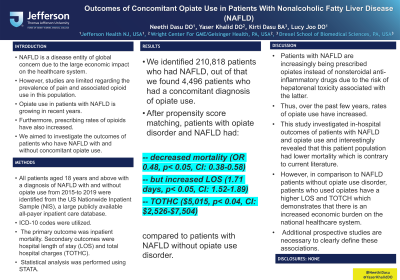Back


Poster Session B - Monday Morning
Category: Liver
B0522 - Outcomes of Concomitant Opiate Use in Patients With Nonalcoholic Fatty Liver Disease (NAFLD)
Monday, October 24, 2022
10:00 AM – 12:00 PM ET
Location: Crown Ballroom

Has Audio

Neethi Dasu, DO
Jefferson Health New Jersey
Voorhees, NJ
Presenting Author(s)
Neethi Dasu, DO1, Yaser Khalid, DO2, Kirti Dasu, BA3, Fizan Khalid, BA4, Lucy Joo, DO5
1Jefferson Health New Jersey, Voorhees, NJ; 2Wright Center for GME/Geisinger Health System, Scranton, PA; 3Drexel Graduate School of Biomedical Sciences and Professional Studies, Philadelphia, PA; 4Commonwealth Health EMS, Scranton, PA; 5Jefferson Health NJ, Cherry Hill, NJ
Introduction: NAFLD is a disease entity of global concern due to the large economic impact on the healthcare system. However, studies are limited regarding the prevalence of pain and associated opioid use in this population. Opiate use in patients with NAFLD is growing in recent years. Furthermore, prescribing rates of opioids have also increased. We aimed to investigate the outcomes of patients who have NAFLD with and without concomitant opiate use.
Methods: All patients aged 18 years and above with a diagnosis of NAFLD with and without opiate use from 2015-to 2019 were identified from the US Nationwide Inpatient Sample (NIS), a large publicly available all-payer inpatient care database. ICD-10 codes were utilized. The primary outcome was inpatient mortality. Secondary outcomes were hospital length of stay (LOS) and total hospital charges (TOTHC). Statistical analysis was performed using STATA.
Results: We identified 210,818 patients who had NAFLD, out of that we found 4,496 patients who had a concomitant diagnosis of opiate use. After propensity score matching, patients with opiate disorder and NAFLD had decreased mortality (OR 0.48, p< 0.05, CI: 0.38-0.58), but increased LOS (1.71 days, p< 0.05, CI: 1.52-1.89) and TOTHC ($5,015, p< 0.04, CI: $2,526-$7,504) compared to patients with NAFLD without opiate use disorder.
Discussion: Patients with NAFLD are increasingly being prescribed opiates instead of nonsteroidal anti-inflammatory drugs due to the risk of hepatorenal toxicity associated with the latter. Thus, over the past few years, rates of opiate use have increased. This study investigated in-hospital outcomes of patients with NAFLD and opiate use and interestingly revealed that this patient population had lower mortality which is contrary to current literature. However, in comparison to NAFLD patients without opiate use disorder, patients who used opiates have a higher LOS and TOTCH which demonstrates that there is an increased economic burden on the national healthcare system. Additional prospective studies are necessary to clearly define these associations.
Disclosures:
Neethi Dasu, DO1, Yaser Khalid, DO2, Kirti Dasu, BA3, Fizan Khalid, BA4, Lucy Joo, DO5. B0522 - Outcomes of Concomitant Opiate Use in Patients With Nonalcoholic Fatty Liver Disease (NAFLD), ACG 2022 Annual Scientific Meeting Abstracts. Charlotte, NC: American College of Gastroenterology.
1Jefferson Health New Jersey, Voorhees, NJ; 2Wright Center for GME/Geisinger Health System, Scranton, PA; 3Drexel Graduate School of Biomedical Sciences and Professional Studies, Philadelphia, PA; 4Commonwealth Health EMS, Scranton, PA; 5Jefferson Health NJ, Cherry Hill, NJ
Introduction: NAFLD is a disease entity of global concern due to the large economic impact on the healthcare system. However, studies are limited regarding the prevalence of pain and associated opioid use in this population. Opiate use in patients with NAFLD is growing in recent years. Furthermore, prescribing rates of opioids have also increased. We aimed to investigate the outcomes of patients who have NAFLD with and without concomitant opiate use.
Methods: All patients aged 18 years and above with a diagnosis of NAFLD with and without opiate use from 2015-to 2019 were identified from the US Nationwide Inpatient Sample (NIS), a large publicly available all-payer inpatient care database. ICD-10 codes were utilized. The primary outcome was inpatient mortality. Secondary outcomes were hospital length of stay (LOS) and total hospital charges (TOTHC). Statistical analysis was performed using STATA.
Results: We identified 210,818 patients who had NAFLD, out of that we found 4,496 patients who had a concomitant diagnosis of opiate use. After propensity score matching, patients with opiate disorder and NAFLD had decreased mortality (OR 0.48, p< 0.05, CI: 0.38-0.58), but increased LOS (1.71 days, p< 0.05, CI: 1.52-1.89) and TOTHC ($5,015, p< 0.04, CI: $2,526-$7,504) compared to patients with NAFLD without opiate use disorder.
Discussion: Patients with NAFLD are increasingly being prescribed opiates instead of nonsteroidal anti-inflammatory drugs due to the risk of hepatorenal toxicity associated with the latter. Thus, over the past few years, rates of opiate use have increased. This study investigated in-hospital outcomes of patients with NAFLD and opiate use and interestingly revealed that this patient population had lower mortality which is contrary to current literature. However, in comparison to NAFLD patients without opiate use disorder, patients who used opiates have a higher LOS and TOTCH which demonstrates that there is an increased economic burden on the national healthcare system. Additional prospective studies are necessary to clearly define these associations.
Disclosures:
Neethi Dasu indicated no relevant financial relationships.
Yaser Khalid indicated no relevant financial relationships.
Kirti Dasu indicated no relevant financial relationships.
Fizan Khalid indicated no relevant financial relationships.
Lucy Joo indicated no relevant financial relationships.
Neethi Dasu, DO1, Yaser Khalid, DO2, Kirti Dasu, BA3, Fizan Khalid, BA4, Lucy Joo, DO5. B0522 - Outcomes of Concomitant Opiate Use in Patients With Nonalcoholic Fatty Liver Disease (NAFLD), ACG 2022 Annual Scientific Meeting Abstracts. Charlotte, NC: American College of Gastroenterology.
